Taiheizan Choshoji Temple
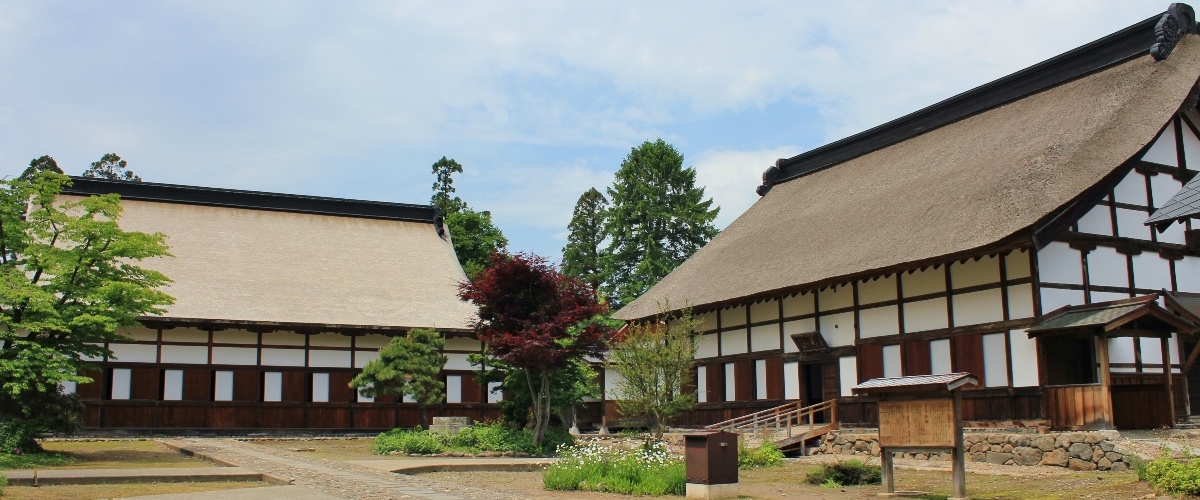
Choshoji Temple was founded in 1528 in Tanesato (now Ajigasawa Town, Nishitsugaru District). As the Tsugaru clan expanded its power, it was relocated to its current location in 1610 to coincide with the construction of Hirosaki Castle. The temple served as a registry office for Soto Zen priests in the territory throughout the feudal period, and it was revered by many as the family temple of the feudal lord's family.
While it was a special temple that provided spiritual support to the Hirosaki Domain, it was also located in a key position under Hirosaki Castle and acted as a defensive stronghold. Referred to as the "Choshoji Kamae," earthen mounds were built along the border between the castle town and Zenringai, and a moat was dug on the west side and along the earthen mounds on the east side. The west and north sides of the Hirosaki plateau are steep cliffs, and served as a space used when departing Hirosaki Castle.
Sect
Soto sect of Zen Buddhism
Principle image
Shaka Nyorai
Visiting information
Choshoji Temple is a temple that is supported by people related to the Tsugaru family and many believers. We are happy to provide sightseeing assistance for "goshuin" (red seal stamp), but in order to welcome all temple visitors and worshippers alike, we are unable to accommodate special requests.
There are no admission fees. After passing through the "Nakamon" gate and "Sanmon" gate, you will see the main hall (without a front entrance) ahead, thatched-roof temple kitchen on your right, "soryukutsu" (Buddhist Statue Hall) on your left, and the mausoleum behind the black wall on the far left. When you enter the temple kitchen, you will find a reception desk where you can receive a "goshuin" (red seal stamp). From there, if you want to visit the main hall, you can walk along the earthen floor on the left with your shoes on. The temple kitchen and the Buddhist Statue Hall are open from 9:00 am to 4:00 pm.
Main hall
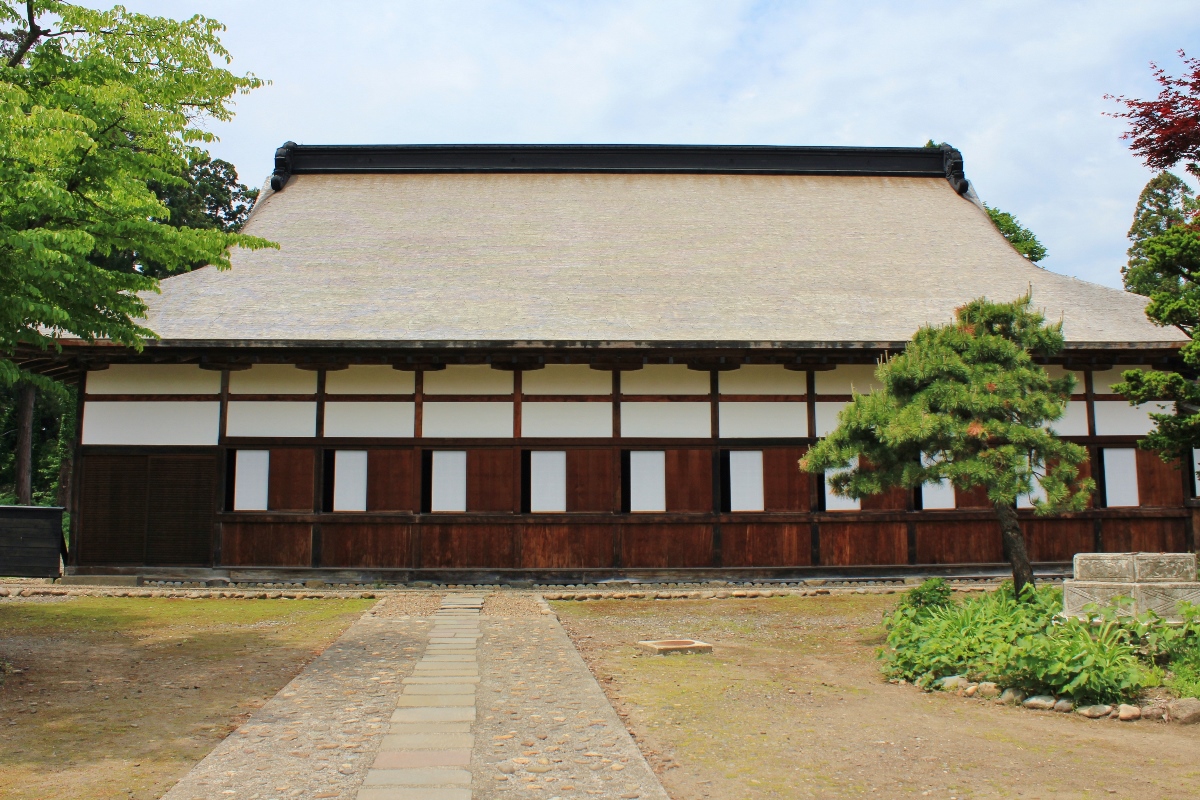
According to temple legend, the Main hall was built in 1610, and the temple kitchen was also reportedly constructed around the same time.
The main hall is a large eight-chamber hall, which has been well preserved in its original form, and is valuable as one of the oldest hojo-style (a hojo is a chamber for a chief priest of the temple) main halls of the Soto sect. Since it was built, it has been renovated and repaired often, but from 2005 to 2008, it underwent a large-scale repair and was restored to its original form. The main entrance, which was added in 1708 and modified during the Meiji period, was removed and replaced with a series of windows, and a 2.73 meter-wide doorway was added at the south end of the building. The eastern half of the wooden floor corridor in the front of the main building was restored as a dirt floor, and the roof was repaired to its original appearance by restoring the tochibuki-style copper shingle roofing to a kokerabuki-style roof.
Important cultural properties
Distance spanned by the longitudinal purlins or plates of the main frame: 22.7 m, distance between the centers of the columns on either side supporting the beam: 16.3 m, single layer, Irimoya-style roof (hip-and-gable roof), wood shingles
Temple kitchen
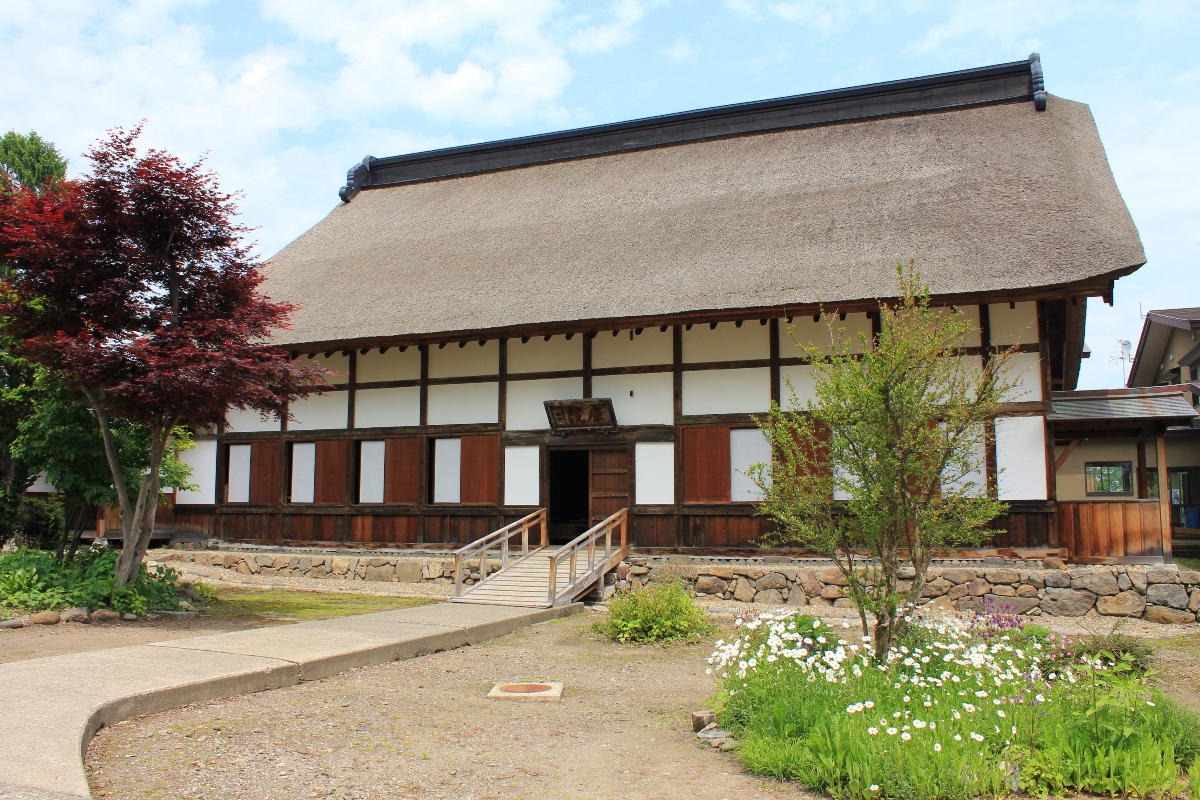
The temple kitchen is characterized by a structure with beams that climb back and forth from the ridge aisle. It was originally reported that the kitchen of Oura Castle, where the Tsugaru clan resided until the latter half of the 16th century, had been relocated, but during the conservation and repair work which was carried out until 2012, it was revealed that it had been rebuilt in 1794. However, a large amount of converted old wood was found in the shaft components, some of which date back to the Middle Ages.
Important cultural properties
Distance spanned by the longitudinal purlins or plates of the main frame: 18.8 m, distance between the centers of the columns on either side supporting the beam: 13.9 m, single layer, gabled roof construction, thatching
Sanmon Gate
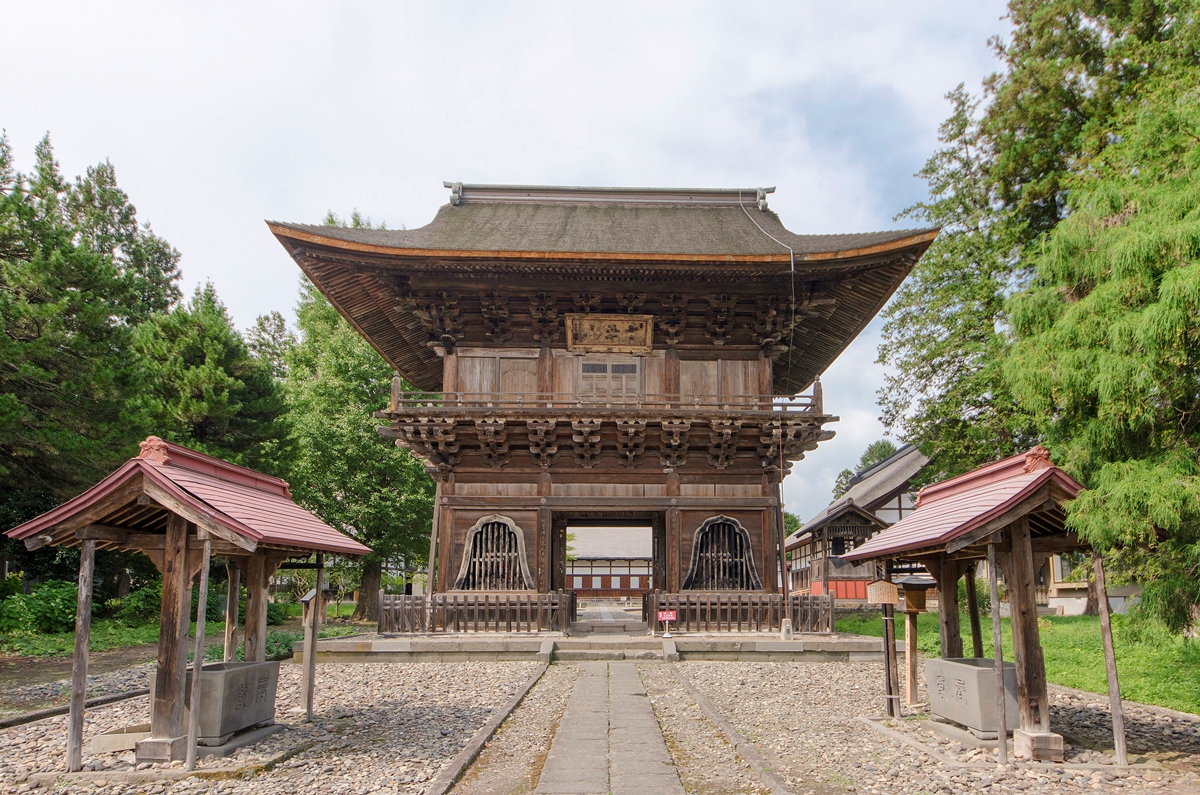
This gate was built in 1629 by Tsugaru Nobuhira, the second feudal lord of the Hirosaki Domain. Thereafter, it underwent several repairs, but during a major repair in 1809, formal changes were made, such as the addition of a katomado (pointed arch or bell-shaped window) in the lower level and the placement of Nio statues (guardians of the Buddha).
The eaves are made of two hanging rafters, and traditional Zen-style architecture is used as the basis of the design, including the use of three-stepped bracket complexes and the use of inverted lotus-shaped columns as the main columns around the upper edge of the building. Like the Iwakiyama Shrine tower gate (built in 1628), it has a special structure with pillars running from top to bottom, and is one of the most important architectural remains of the early Edo period.
Important cultural properties
Distance spanned by the longitudinal purlins or plates of the main frame: 9.7 m, distance between the centers of the columns on either side supporting the beam: 5.8 m, building height: 16.2 m, tower gate that stands three bays wide with the middle bay serving as an entrance, hip-and-gable roof construction, tochibuki roof (shingling using thick roof shingles)
Mieido Hall
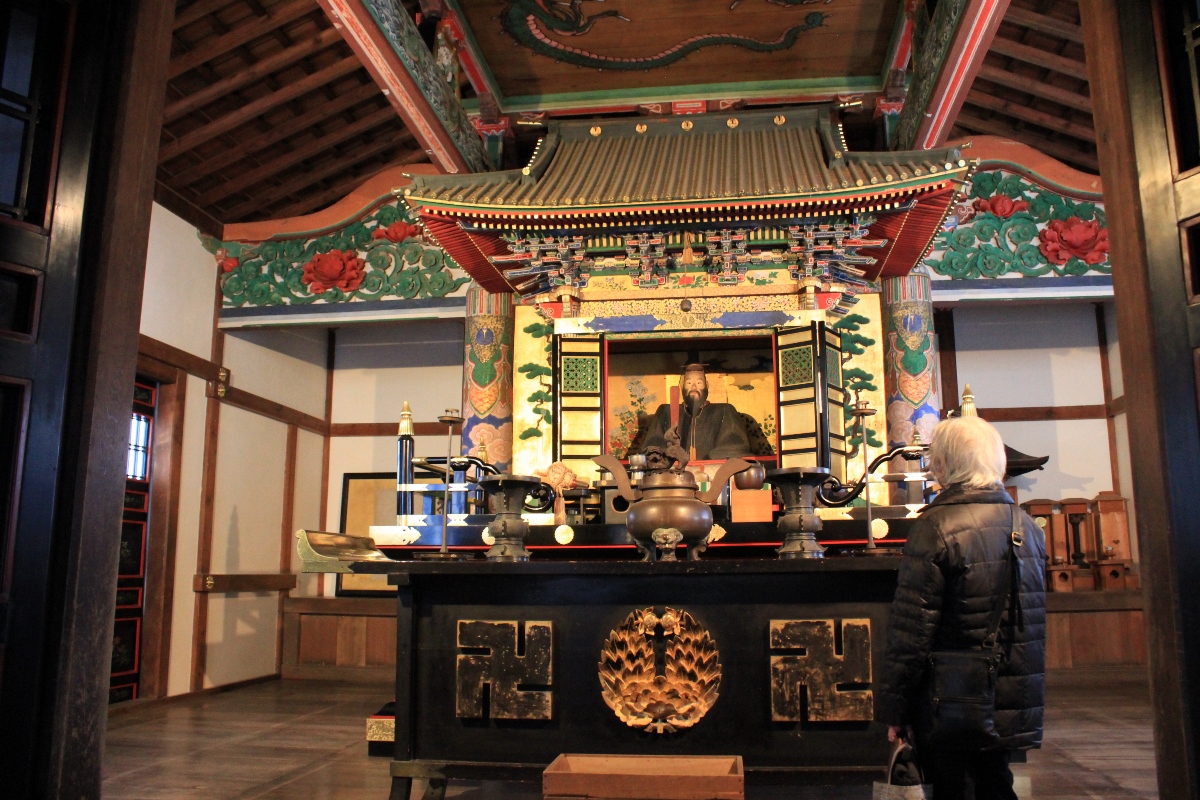
The Mieido Hall enshrines a wooden statue of Tsugaru Tamenobu, the first lord of the Hirosaki Domain (prefectural treasure), and the Zushi (miniature shrine used to store Buddhist items) and Shumidan (dais for a Buddhist image) inside were recognized as important art treasures. It is said to have been built in 1629, the same year as the Sanmon Gate, and in 1805, the foundation was newly rebuilt and the direction of the front was changed from south to east during the building relocation, and full-scale painting work was also carried out.
It has a hosangen-style structure and a hogyo-zukuri style copper shingle roof with two eaves with sparse rafters. In the center of the four-quarter room, there is a black lacquered door with floral designs painted with a technique known as mitsuda-e on the inside. The interior structure is mainly made of rainbow-shaped beams, and the round pillars and ceiling are decorated with paintings and patterns in rich colors. The Zushi is also gorgeous, with many gold leaves and gold mud used in various parts.
This building is valuable as a shrine dedicated to the ancestors of the Tsugaru clan, and is combined with the mausoleums of the Tsugaru clan to the south.
*The Mieido Hall and the mausoleums of the Tsugaru clan are usually not open to the public.
Important cultural properties
Distance spanned by the longitudinal purlins or plates of the main frame: 5.46 m, distance between the centers of the columns on either side supporting the beam: 5.46 m, single layer, hogyo-zukuri style (pyramidal style of roof constructed over a square building), shingle roofing
Wooden statue of Tsugaru Tamenobu enshrined in the Zushi inside the Mieido Hall
Prefectural treasure
It is said that Tsugaru Tamenobu, who traveled to Kyoto in 1606 to cure his illness, ordered a Buddhist priest to make the wooden statue, and after his death, it was enshrined at Kakushuji Temple, but when the temple was destroyed by fire, it was moved to Choshoji Temple.
It is wearing a traditional ceremonial court dress and a crown made separately from the main statue, and is seated on a box-like platform with a scepter on the right-hand sleeve. The structure of the kiyose (a technique used to make the main part of a wooden statue out of two or more pieces of wood) is unclear due to the coloring, but the head is inserted into the body by the neck handle. It has crystal eyes, a robe decorated with a series of plant patterns in black and light black, and a checkered pattern in white and silver mud on the hakama (a long pleated skirt worn over a kimono).
Although the body is very formalized due to the common practice of the times, the noble face suggests the intention of portraying the figure as a portrait.
*The Mieido Hall and the mausoleums of the Tsugaru clan are usually not open to the public.
Mausoleums of the Tsugaru clan
The mausoleums of the Tsugaru clan are arranged in an almost straight line to the south of the Mieido Hall, all facing east and surrounded by a fence with a gate in the front of the structure.
The front has a Sankarado (paneled wooden door) and the others are wooden walls, and each side of each building is decorated with the Tsugaru family crest, which is an apricot leaf peony (gyoyobotan), on the outer surface, while each side of the Meikyodai is decorated with a crest of a hollyhock showing the origin of the Tsugaru Nobuhira Yojyuin.
Inside, a stone Muhoutou (multiple-storied monument dedicated to Buddha) is enshrined, the walls are covered with wooden grave tablets, and the mirrored ceiling is decorated with pictures of heavenly maidens on Hakuundai and dragons on the other four buildings. They all belong to the early to mid-Edo period, and the view of the rows of these authentically constructed mausoleums is outstanding, making them important as a group of mausoleums from the early modern period that are clearly dated.
*The Goeido Hall and the mausoleums of the Tsugaru clan are usually not open to the public.
Important cultural property
Two rooms, hip-and-gable roof structure, kokerabuki-style roof
Kangetsudai
(mausoleum of Tsugaru Tamenobu, the first feudal lord of the Tsugaru clan): Built in 1672
Hekigandai
(mausoleum of Tsugaru Nobuhira, the second feudal lord of the Tsugaru clan): Built in 1631
Meikyodai
(mausoleum of Tsugaru Nobuhira's wife, wife of the second feudal lord of the Tsugaru clan): Built in 1638
Hakuundai
(mausoleum of Tsugaru Nobuyoshi, the third feudal lord of the Tsugaru clan): Built in 1656
Ryouundai
(mausoleum of Tsugaru Nobuaki, the sixth feudal lord of the Tsugaru clan): Built in 1753
Sanzonbutsu (three Buddhist deities) and its Zushi-do (miniature shrine)
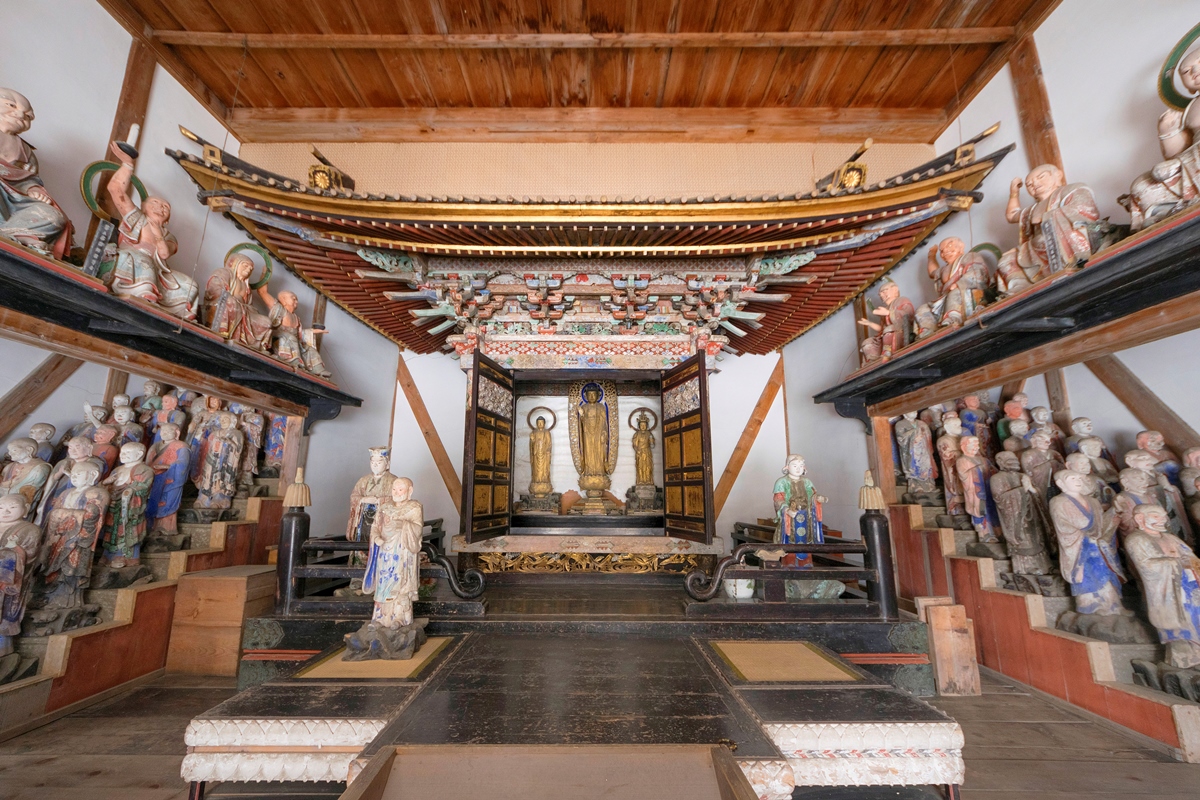
Prefectural treasure
The statues were donated in 1610 by Tsugaru Nobuhira, the second lord of the Hirosaki Domain, as the principal image in the main sanctuary hall of Hyakutakuji Temple (Iwakiyama Shrine worship hall, designated as a National Important Cultural Property), and the Zushi was built in 1638 by Tsugaru Nobuyoshi, the third lord of the Hirosaki Domain, as a palace in which the principal image was enshrined.
The three images of the Sanzonbutsu are worshipped as the main Buddha of the Iwakiyama Sansho Daigongen, and depict Amida Nyorai on the central peak of Mount Iwaki, the eleven-faced Kannon on the eastern peak of Mount Ganki, and Yakushi Nyorai on the western peak of Mount Chokai. The three of them are sculpted in the warihagi style and gofun foil finish.
The Zushi is an 181 cm-wide room with a wooden tile roof with an Irimoya-style roof (hip-and-gable roof), and the eaves are made of double eaves (futanoki) with fan rafters (ougidaruki). The three sides excluding the back are decorated with carvings of dragons and karamatsu (Japanese larch), and the door is also decorated with carvings of karyobinga (a fantastical immortal creature in Buddhism, with a human head and a bird's torso).
In 1873, the roof of the Zushi was removed when the temple was moved to the Chosho-ji Zendo Hall (meditation hall) due to the separation of Shinto and Buddhism.
Choshoji Kamae (commonly known as "Zenringai")
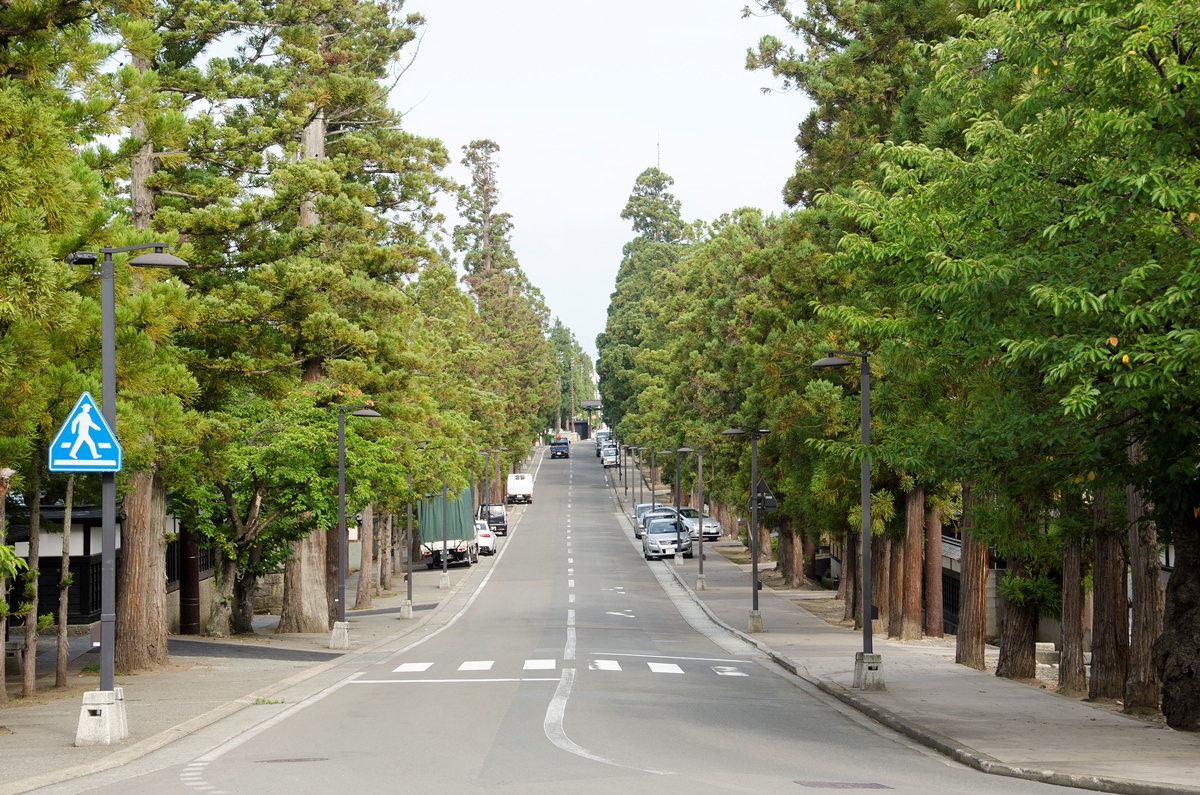
In 1610, Tsugaru Nobuhira, the second feudal lord of the Hirosaki Domain, began construction of a new castle and ordered Horikoshi and other temples and shrines in the domain to move to the new castle town. These temples and shrines were located at key points under the castle, and the temple district centering on Chosho-ji Temple served as the seizure point in the southwest.
In January 1615, Shigemoriyama, located to the south of the main castle, was cut down because it was higher than the castle walls and overlooked the castle. In March of the same year, a moat was dug between the gate of Choshoji Temple and Shigemoriyama, built an earthen shrine and set up a square. The temple district was located to its west and consisted of 33 temples of the Soto school of Buddhism alone. In the surrounding area, from north to west, are cliffs, which act as a natural obstacle. This is what is known as the Choshoji Kamae, which constitutes the side structure of Hirosaki Castle.
This area is important for understanding the history of the castle town of Hirosaki and the religious policy of the Hirosaki clan.
JAPANESE PAGE